
Dimdima
Online Children's Magazine from India

Dimdima
Online Children's Magazine from India
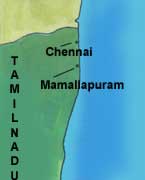
Our journey along the Coromandel coast, takes us to Mamallapuram, an ancient port of the Pallavas. It is believed to have been named after the 7th century Pallavan king, Narasimhavarman, who was given the title 'Mahamalla', meaning the 'great wrestler'. It was during his rule that Mahamallapuram which was later called Mamallapuram attained great prosperity. The famous port of the Pallavas no longer exists but the open-air museum of rock-cut monuments they left behind still remains. One of the outstanding monuments here is a bas-relief known as Arjuna's Penance or the Descent of the Ganga. It is 29m long and 13m high and is believed to be the largest bas-relief in the world. In the monsoons, rainwater flows down a natural cleft in the centre of the rock-relief simulating the descent of the mighty river Ganga.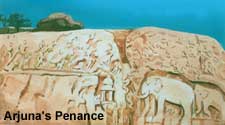
Among the rock-cut temples at Mamallapuram, the rathas are most famous. These are shaped like chariots and are named after four Pandava brothers Yudhishthira, Arjuna, Bhima, Sahadeva, and Draupadi, the wife of the Pandavas.
The Varaha and the Mahishasuramardini caves that lie to the east of the bas-relief contain friezes that depict mythological stories.
A large panel in the Varaha cave tells the story of how Lord Vishnu takes the form of the gigaIitic boar Varaha and rescues the Earth goddess from the clutches of the demon Hiranyaksha.
The Mahishasuramardini cave has two friezes. One of them depicts the great battle in which the arch-demon
 Mahishasura is killed. Mahishasura had become so powerful that he had succeeded in driving Indra and the other gods away from heaven. The gods could not bear the evil that prevailed. In desperation, they sat in council, pooled their divine resources and created 'Ambika' (Durga), a goddess who possessed all their attributes, power and weapons, as well as the qualities of their consorts. The invincible goddess battled 'with the demonic forces and destroyed Mahishasura. She was called Mahishasuramardini thereafter and it is in this form that she is worshipped during the nine-day-festival of Navratri or Durga Puja. The frieze shows the goddess mounted on a prancing lion attacking the buffalo-headed demon. The panel opposite shows Vishnu in his cosmic sleep.
Mahishasura is killed. Mahishasura had become so powerful that he had succeeded in driving Indra and the other gods away from heaven. The gods could not bear the evil that prevailed. In desperation, they sat in council, pooled their divine resources and created 'Ambika' (Durga), a goddess who possessed all their attributes, power and weapons, as well as the qualities of their consorts. The invincible goddess battled 'with the demonic forces and destroyed Mahishasura. She was called Mahishasuramardini thereafter and it is in this form that she is worshipped during the nine-day-festival of Navratri or Durga Puja. The frieze shows the goddess mounted on a prancing lion attacking the buffalo-headed demon. The panel opposite shows Vishnu in his cosmic sleep.
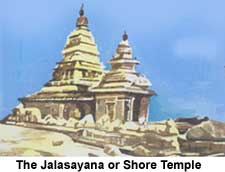
The Jalasayana or Shore Temple, stands nearby. It was built so close to the sea that it could be entered only from the back. The temple is dedicated to Siva and has several 'nandis' on the parapet of the wall surrounding it.
Mamallapuram is also the birthplace of the great 5th century Vaishnav saint,Bhutattalavar.
As we leave the glorious pallava legacy behind and continue our coastal journey, we come across an artists' commune called the Cholamandalam Artists Village. The artists who live here make their living by selling their work. There is a permanent exhibition of paintings, sketches, terracotta sculptures and other crafts, and regular poetry reading sessions and dance recitals are held in this village.
Our next halt is at the capital of Tamil Nadu, the fourth largest Indian city. Chennai, formerly Madras, is located on a 17km stretch on the Coromandel coast.
It is regarded as the 'Gateway of the South'.
In the seventeenth century when the British decided to build a factory on the east coast they selected Armagaum, a village around 40km north of present-day Chennai, as the site. But they soon realised that the place was unsuitable for trade purposes. So Francis Day, the chief of the Armagaum factory sailed southwards to acquire a suitable site. On 22nd July,1639, he succeeded in securing the grant of a fishing village called Madras Kuppam from Damarla Venkatadri Nayak, a vassal of the Rajah of Chandragiri. It was from this narrow, surfwracked, no man's land which the
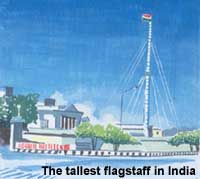 locals called 'narimedu', a 'Jackal mound' that the city of Madras was born.
locals called 'narimedu', a 'Jackal mound' that the city of Madras was born.
Day established the British factory here and to protect it and the British settlement that had sprung up there, he built a fort and named it after the patron saint of England, St. George, as its construction was completed on St. George's Day (23rd April,1640).
The Church of St. Mary in the fort was the first Anglican church to come up in India. It was built in 1680 and its courtyard is paved with the oldest British tombstones in the country. Governor Elihu Yale, who later founded the Yale University in the US, was the first to get married here. The old colours of the Madras Fusiliers, the first European regiment of the East India Company, are displayed in the church.

The Fort Museum has historical documents, oil paintings, coins, medals, weapons, sculptures and other artefacts depicting the city's early days. The building was established in 1683, when it housed the Bank of Madras, the first modern bank in India and a forerunner of the Imperial and State Banks; the Fort Exchange, where businessmen transacted business, and a lighthouse on the roof. The 50m-high teakwood flagstaff at Fort St. George is the tallest in the country. The Secretariat and the Legislative Assembly of the Tamil Nadu government are the important buildings in the fort today. The broad, sandy Marina Beach, not far from the Fort, is regarded as the second longest beach in the world. It is 3 1/2 kilometres long. It has the samadhi of C.N.Annadurai, one of the most popular chief ministers of Tamil Nadu.
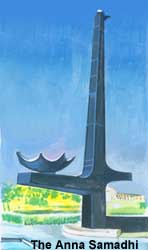
Annadurai, affectionately called 'Anna' (elder brother) had ushered in a new era of Tamil consciousness in 1967 when his party, the Dravida Munnetra Kazhagam came to power. His death barely a year later dealt a shattering blow to the people of Tamil Nadu. Millions gathered at the beach and wept as he was cremated. The Anna Samadhi is now a place of pilgrimage. Hundreds come everyday and dream of the world that might have been had their Anna been alive.
Last updated on :7/1/2005
Dimdima is the Sanskrit word for ‘drumbeat’. In olden days, victory in battle was heralded by the beat of drums or any important news to be conveyed to the people used to be accompanied with drumbeats.
Bharatiya Vidya Bhavan
K. M Munshi Marg,
Chowpatty, Mumbai - 400 007
email : editor@dimdima.com
Bharatiya Vidya Bhavan
505, Sane Guruji Marg,
Tardeo, Mumbai - 400 034
email : promo@dimdima.com
Dimdima.com, the Children's Website of Bharatiya Vidya Bhavan launched in 2000 and came out with a Printed version of Dimdima Magazine in 2004. At present the Printed Version have more than 35,000 subscribers from India and Abroad.